Estimating the Soil Copper Content of Urban Land in a Megacity Using Piecewise Spectral Pretreatment
Abstract
:1. Introduction
2. Materials and Methods
2.1. Study Area
2.2. Sample Collection
2.3. Soil Spectral Measurement and Chemical Analysis
2.4. Piecewise Spectral Pretreatment
2.4.1. Traditional Spectral Pretreatment
2.4.2. Piecewise Spectral Pretreatment
- (1)
- One-part pretreatment strategy. Only one part of the spectrum was pretreated, leaving the other two parts untreated. These three parts we then combined to construct the Cu estimation model. Only one of the three parts (left part, middle part, and right) was pretreated using six different methods, resulting in 18 models (*6 = 18). For example, only the middle part of the spectrum was pretreated with SG, leaving the left and right untreated. This one-part pretreatment method was denoted as “No–SG–No”.
- (2)
- Two-part pretreatment strategy. Two parts of the spectrum were pretreated, leaving one part untreated. The three parts were then merged to construct the Cu estimation model. Only two out of the three parts (left-middle, left-right, and middle-right) were pretreated using six different methods, resulting in 108 models (*6*6 = 108). For example, SG was applied to the middle part and MSC to the right part, leaving the left part untreated. This two-part pretreatment method was denoted as “No–SG–MSC”.
- (3)
- Three-part pretreatment strategy. All three parts of the spectrum were pretreated and then merged together to construct the Cu estimation model. All three parts (left part, middle part, and right) were pretreated using six different methods, resulting in 342 models (*6*6*6 = 216). For example, FD was used for the left part, SG for the middle, and MSC for the right part. This three-part pretreatment method was denoted as “FD–SG–MSC”.
2.5. PLSR Models
2.6. Performancce of Models
3. Results
3.1. Descriptive Statistics of Soil Samples
3.2. Estimation Accuracy of Cu Models with the Traditional Spectral Pretreatment
3.3. Estimation Accuracy of Cu Models with Piecewise Pretreatment
3.3.1. One Part Was Pretreated
3.3.2. Two Parts Were Pretreated
3.3.3. Three Parts Were Pretreated
3.3.4. Comparison of One-Part, Two-Part, and Three-Part Strategies
4. Discussion
4.1. Influence of Piecewise Pretreatment on Cu Estimation Model
4.2. How Piecewise Pretreatment Affects Cu Models
5. Conclusions
Author Contributions
Funding
Data Availability Statement
Acknowledgments
Conflicts of Interest
References
- Xu, J.; Liu, C.; Hsu, P.-C.; Zhao, J.; Wu, T.; Tang, J.; Liu, K.; Cui, Y. Remediation of heavy metal contaminated soil by asymmetrical alternating current electrochemistry. Nat. Commun. 2019, 10, 2440. [Google Scholar] [CrossRef]
- Hou, D.; O’Connor, D.; Igalavithana, A.D.; Alessi, D.S.; Luo, J.; Tsang, D.C.; Sparks, D.L.; Yamauchi, Y.; Rinklebe, J.; Ok, Y.S. Metal contamination and bioremediation of agricultural soils for food safety and sustainability. Nat. Rev. Earth Environ. 2020, 1, 366–381. [Google Scholar] [CrossRef]
- Zhang, X.; Yan, L.; Liu, J.; Zhang, Z.; Tan, C. Removal of Different Kinds of Heavy Metals by Novel PPG-nZVI Beads and Their Application in Simulated Stormwater Infiltration Facility. Appl. Sci. 2019, 9, 4213. [Google Scholar] [CrossRef]
- Alengebawy, A.; Abdelkhalek, S.T.; Qureshi, S.R.; Wang, M.-Q. Heavy metals and pesticides toxicity in agricultural soil and plants: Ecological risks and human health implications. Toxics 2021, 9, 42. [Google Scholar] [CrossRef] [PubMed]
- Nriagu, J.O. A history of global metal pollution. Science 1996, 272, 223. [Google Scholar] [CrossRef]
- Soliman, M.M.; Hesselberg, T.; Mohamed, A.A.; Renault, D. Trophic transfer of heavy metals along a pollution gradient in a terrestrial agro-industrial food web. Geoderma 2022, 413, 115748. [Google Scholar] [CrossRef]
- Chary, N.S.; Kamala, C.; Raj, D.S.S. Assessing risk of heavy metals from consuming food grown on sewage irrigated soils and food chain transfer. Ecotoxicol. Environ. Saf. 2008, 69, 513–524. [Google Scholar] [CrossRef]
- Shi, T.; Liu, H.; Chen, Y.; Fei, T.; Wang, J.; Wu, G. Spectroscopic Diagnosis of Arsenic Contamination in Agricultural Soils. Sensors 2017, 17, 1036. [Google Scholar] [CrossRef] [PubMed]
- Li, S.; Visscarra Rossel, R.A.; Webster, R. The cost-effectiveness of reflectance spectroscopy for estimating soil organic carbon. Eur. J. Soil Sci. 2022, 73, e13202. [Google Scholar] [CrossRef]
- Kuang, B.; Mouazen, A.M. Influence of the number of samples on prediction error of visible and near infrared spectroscopy of selected soil properties at the farm scale. Eur. J. Soil Sci. 2012, 63, 421–429. [Google Scholar] [CrossRef]
- Dor, E.B.; Granot, A.; Wallach, R.; Francos, N.; Pearlstein, D.H.; Efrati, B.; Borůvka, L.; Gholizadeh, A.; Schmid, T. Exploitation of the SoilPRO®(SP) apparatus to measure soil surface reflectance in the field: Five case studies. Geoderma 2023, 438, 116636. [Google Scholar] [CrossRef]
- Viscarra Rossel, R.A.; Lobsey, C.R.; Sharman, C.; Flick, P.; McLachlan, G. Novel soil profile sensing to monitor organic C stocks and condition. Environ. Sci. Technol. 2017, 51, 5630–5641. [Google Scholar] [CrossRef] [PubMed]
- Shi, T.; Chen, Y.; Liu, Y.; Wu, G. Visible and near-infrared reflectance spectroscopy—An alternative for monitoring soil contamination by heavy metals. J. Hazard. Mater. 2014, 265, 166–176. [Google Scholar] [CrossRef] [PubMed]
- Viscarra Rossel, R.A.; Behrens, T.; Ben-Dor, E.; Chabrillat, S.; Dematte, J.A.M.; Ge, Y.; Gomez, C.; Guerrero, C.; Peng, Y.; Ramirez-Lopez, L.; et al. Diffuse reflectance spectroscopy for estimating soil properties: A technology for the 21st century. Eur. J. Soil Sci. 2022, 73, e13271. [Google Scholar] [CrossRef]
- Liu, Y.; Liu, Y.; Chen, Y.; Zhang, Y.; Shi, T.; Wang, J.; Hong, Y.; Fei, T.; Zhang, Y. The Influence of Spectral Pretreatment on the Selection of Representative Calibration Samples for Soil Organic Matter Estimation Using Vis-NIR Reflectance Spectroscopy. Remote Sens. 2019, 11, 450. [Google Scholar] [CrossRef]
- Viscarra Rossel, R.A.; Cattle, S.R.; Ortega, A.; Fouad, Y. In situ measurements of soil colour, mineral composition and clay content by vis-NIR spectroscopy. Geoderma 2009, 150, 253–266. [Google Scholar] [CrossRef]
- Viscarra Rossel, R.A.; Webster, R. Discrimination of Australian soil horizons and classes from their visible–near infrared spectra. Eur. J. Soil Sci. 2011, 62, 637–647. [Google Scholar] [CrossRef]
- Stenberg, B.; Viscarra Rossel, R.A.; Mouazen, A.M.; Wetterlind, J. Chapter five-visible and near infrared spectroscopy in soil science. Adv. Agron. 2010, 107, 163–215. [Google Scholar]
- Xiao, Q.; Tang, W.; Zhang, C.; Zhou, L.; Feng, L.; Shen, J.; Yan, T.; Gao, P.; He, Y.; Wu, N. Spectral preprocessing combined with deep transfer learning to evaluate chlorophyll content in cotton leaves. Plant Phenomics 2022, 2022, 9813841. [Google Scholar] [CrossRef]
- Gholizadeh, A.; Borůvka, L.; Saberioon, M.; Vašát, R. Visible, near-infrared, and mid-infrared spectroscopy applications for soil assessment with emphasis on soil organic matter content and quality: State-of-the-art and key issues. Appl. Spectrosc. 2013, 67, 1349–1362. [Google Scholar] [CrossRef]
- Gholizadeh, A.; Carmon, N.; Klement, A.; Ben-Dor, E.; Borůvka, L. Agricultural Soil Spectral Response and Properties Assessment: Effects of Measurement Protocol and Data Mining Technique. Remote Sens. 2017, 9, 1078. [Google Scholar] [CrossRef]
- Peng, X.; Shi, T.; Song, A.; Chen, Y.; Gao, W. Estimating Soil Organic Carbon Using VIS/NIR Spectroscopy with SVMR and SPA Methods. Remote Sens. 2014, 6, 2699–2717. [Google Scholar] [CrossRef]
- Ba, Y.; Liu, J.; Han, J.; Zhang, X. Application of Vis-NIR spectroscopy for determination the content of organic matter in saline-alkali soils. Spectrochim. Acta Part A Mol. Biomol. Spectrosc. 2020, 229, 117863. [Google Scholar] [CrossRef] [PubMed]
- Barra, I.; Haefele, S.M.; Sakrabani, R.; Kebede, F. Soil spectroscopy with the use of chemometrics, machine learning and pre-processing techniques in soil diagnosis: Recent advances—A review. Trac-Trends Anal. Chem. 2021, 135, 116166. [Google Scholar] [CrossRef]
- Gholizadeh, A.; Borůvka, L.; Saberioon, M.M.; Kozák, J.; Vašát, R.; Němeček, K. Comparing different data preprocessing methods for monitoring soil heavy metals based on soil spectral features. Soil Water Res. 2015, 10, 218–227. [Google Scholar] [CrossRef]
- Dotto, A.C.; Diniz Dalmolin, R.S.; Grunwald, S.; ten Caten, A.; Pereira Filho, W. Two preprocessing techniques to reduce model covariables in soil property predictions by Vis-NIR spectroscopy. Soil Tillage Res. 2017, 172, 59–68. [Google Scholar] [CrossRef]
- Vasques, G.; Grunwald, S.; Sickman, J. Comparison of multivariate methods for inferential modeling of soil carbon using visible/near-infrared spectra. Geoderma 2008, 146, 14–25. [Google Scholar] [CrossRef]
- Nawar, S.; Buddenbaum, H.; Hill, J.; Kozak, J.; Mouazen, A.M. Estimating the soil clay content and organic matter by means of different calibration methods of vis-NIR diffuse reflectance spectroscopy. Soil Tillage Res. 2016, 155, 510–522. [Google Scholar] [CrossRef]
- Yu, S.; Huan, K.W.; Liu, X.X.; Wang, L.; Cao, X.W. Quantitative model of near infrared spectroscopy based on pretreatment combined with parallel convolution neural network. Infrared Phys. Technol. 2023, 132, 104730. [Google Scholar] [CrossRef]
- Dotto, A.C.; Diniz Dalmolin, R.S.; ten Caten, A.; Grunwald, S. A systematic study on the application of scatter-corrective and spectral-derivative preprocessing for multivariate prediction of soil organic carbon by Vis-NIR spectra. Geoderma 2018, 314, 262–274. [Google Scholar] [CrossRef]
- Wang, Z.; Chen, S.C.; Lu, R.; Zhang, X.L.; Ma, Y.X.; Shi, Z. Non-linear memory-based learning for predicting soil properties using a regional vis-NIR spectral library. Geoderma 2024, 441, 116752. [Google Scholar] [CrossRef]
- Yang, W.; Xiong, Y.; Xu, Z.; Li, L.; Du, Y. Piecewise preprocessing of near-infrared spectra for improving prediction ability of a PLS model. Infrared Phys. Technol. 2022, 126, 104359. [Google Scholar] [CrossRef]
- Peng, Q.Z.; Tang, L.; Chen, J.; Wu, Y.L.; Chen, X.Z. Study on the Evolution of Construction Land Slope Spectrum in Shenzhen during 2000–2015. J. Nat. Resour. 2018, 33, 2200–2212. [Google Scholar]
- Zhang, W.; Xu, A.; Zhang, R.; Ji, H. Review of Soil Classification and Revision of China Soil Classification System. Sci. Agric. Sin. 2014, 47, 3214–3230. [Google Scholar]
- Lin, T.; Zhao, S.H.; Xi, X.P.; Yang, K.; Luo, F. Environmental Background Values of Heavy Metals and Physicochemical Properties in Different Soils in Shenzhen. Environ. Sci. 2021, 42, 3518–3526. [Google Scholar]
- Mousavi, F.; Abdi, E.; Ghalandarzadeh, A.; Bahrami, H.A.; Majnounian, B.; Ziadi, N. Diffuse reflectance spectroscopy for rapid estimation of soil Atterberg limits. Geoderma 2020, 361, 114083. [Google Scholar] [CrossRef]
- Wang, C.; Yang, Z.; Yuan, X.; Browne, P.; Chen, L.; Ji, J. The influences of soil properties on Cu and Zn availability in soil and their transfer to wheat t (Triticum aestivum L.) in the Yangtze River delta region, China. Geoderma 2013, 193, 131–139. [Google Scholar] [CrossRef]
- Lindsay, W.L.; Norvell, W.A. Development of a DTPA Soil Test for Zinc, Iron, Manganese, and Copper1. Soil Sci. Soc. Am. J. 1978, 42, 421–428. [Google Scholar] [CrossRef]
- Rinnan, Å.; Berg, F.V.D.; Engelsen, S.B. Review of the most common pre-processing techniques for near-infrared spectra. TrAC Trends Anal. Chem. 2009, 28, 1201–1222. [Google Scholar] [CrossRef]
- Echambadi, R.; Hess, J.D. Mean-centering does not alleviate collinearity problems in moderated multiple regression models. Mark. Sci. 2007, 26, 438–445. [Google Scholar] [CrossRef]
- Hook, J. Smoothing non-smooth systems with low-pass filters. Phys. D Nonlinear Phenom. 2014, 269, 76–85. [Google Scholar] [CrossRef]
- Shetty, N.; Gislum, R. Quantification of fructan concentration in grasses using NIR spectroscopy and PLSR. Field Crops Res. 2011, 120, 31–37. [Google Scholar] [CrossRef]
- West, J.B.; Bowen, G.J.; Dawson, T.E.; Tu, K.P. Isoscapes: Understanding Movement, Pattern, and Process on Earth through Isotope Mapping; Springer: Dordrecht, The Netherlands, 2009; Volume 3, p. 76. [Google Scholar]
- Elmer, K.; Soffer, R.; Arroyo-Mora, J.P.; Kalacska, M. ASDToolkit: A Novel MATLAB Processing Toolbox for ASD Field Spectroscopy Data. Data 2020, 5, 96. [Google Scholar] [CrossRef]
- Goodarzi, M.; Sharma, S.; Ramon, H.; Saeys, W. Multivariate calibration of NIR spectroscopic sensors for continuous glucose monitoring. TrAC Trends Anal. Chem. 2015, 67, 147–158. [Google Scholar] [CrossRef]
- Della Riccia, G.; Del Zotto, S. A multivariate regression model for detection of fumonisins content in maize from near infrared spectra. Food Chem. 2013, 141, 4289–4294. [Google Scholar]
- Yang, Q.; Jiang, Z.; Li, W.; Li, H. Prediction of soil organic matter in peak-cluster depression region using kriging and terrain indices. Soil Tillage Res. 2014, 144, 126–132. [Google Scholar] [CrossRef]
- Liu, Y.; Li, W.; Wu, G.; Xu, X. Feasibility of estimating heavy metal contaminations in floodplain soils using laboratory-based hyperspectral data—A case study along Le’an River, China. Geo-Spat. Inf. Sci. 2011, 14, 10–16. [Google Scholar] [CrossRef]
- Riedel, F.; Denk, M.; Müller, I.; Barth, N.; Glässer, C. Prediction of soil parameters using the spectral range between 350 and 15,000 nm: A case study based on the Permanent Soil Monitoring Program in Saxony, Germany. Geoderma 2018, 315, 188–198. [Google Scholar] [CrossRef]
- Cheng, H.; Shen, R.; Chen, Y.; Wan, Q.; Shi, T.; Wang, J.; Wan, Y.; Hong, Y.; Li, X. Estimating heavy metal concentrations in suburban soils with reflectance spectroscopy. Geoderma 2019, 336, 59–67. [Google Scholar] [CrossRef]
- Wu, Y.; Chen, J.; Ji, J.; Gong, P.; Liao, Q.; Tian, Q.; Ma, H. A mechanism study of reflectance spectroscopy for investigating heavy metals in soils. Soil Sci. Soc. Am. J. 2007, 71, 918–926. [Google Scholar] [CrossRef]
- Malley, D.F.; Williams, P.C. Use of near-infrared reflectance spectroscopy in prediction of heavy metals in freshwater sediment by their association with organic matter. Environ. Sci. Technol. 1997, 31, 3461–3467. [Google Scholar] [CrossRef]
- Song, Y.; Li, F.; Yang, Z.; Ayoko, G.A.; Frost, R.L.; Ji, J. Diffuse reflectance spectroscopy for monitoring potentially toxic elements in the agricultural soils of Changjiang River Delta, China. Appl. Clay Sci. 2012, 64, 75–83. [Google Scholar] [CrossRef]
- Chong, I.G.; Jun, C.H. Performance of some variable selection methods when multicollinearity is present. Chemom. Intell. Lab. Syst. 2005, 78, 103–112. [Google Scholar] [CrossRef]
- Trap, J.; Bureau, F.; Perez, G.; Aubert, M. PLS-regressions highlight litter quality as the major predictor of humus form shift along forest maturation. Soil Biol. Biochem. 2013, 57, 969–971. [Google Scholar] [CrossRef]
- Xie, X.L.; Pan, X.Z.; Sun, B. Visible and Near-Infrared Diffuse Reflectance Spectroscopy for Prediction of Soil Properties near a Copper Smelter. Pedosphere 2012, 22, 351–366. [Google Scholar] [CrossRef]
- Pyo, J.; Hong, S.M.; Kwon, Y.S.; Kim, M.S.; Cho, K.H. Estimation of heavy metals using deep neural network with visible and infrared spectroscopy of soil. Sci. Total Environ. 2020, 741, 140162. [Google Scholar] [CrossRef] [PubMed]
- Dhanoa, M.; Lister, S.; Sanderson, R.; Barnes, R. The Link between Multiplicative Scatter Correction (MSC) and Standard Normal Variate (SNV) Transformations of NIR Spectra. J. Near Infrared Spectrosc. 1994, 2, 43–47. [Google Scholar] [CrossRef]
- Candolfi, A.; De Maesschalck, R.; Jouan-Rimbaud, D.; Hailey, P.A.; Massart, D.L. The influence of data pre-processing in the pattern recognition of excipients near-infrared spectra. J. Pharm. Biomed. Anal. 1999, 21, 115–132. [Google Scholar] [CrossRef]
- Chang, C.-W.; Laird, D.A. Near-infrared reflectance spectroscopic analysis of soil C and N. Soil Sci. 2002, 167, 110–116. [Google Scholar] [CrossRef]
- Xu, D.Y.; Chen, S.C.; Xu, H.Y.; Wang, N.; Zhou, Y.; Shi, Z. Data fusion for the measurement of potentially toxic elements in soil using portable spectrometers. Environ. Pollut. 2020, 263, 114649. [Google Scholar] [CrossRef]
- Camargo, L.A.; Marques, J., Jr.; Barron, V.; Ferracciu Alleoni, L.R.; Pereira, G.T.; Teixeira, D.D.B.; Rabelo de Souza Bahia, A.S. Predicting potentially toxic elements in tropical soils from iron oxides, magnetic susceptibility and diffuse reflectance spectra. Catena 2018, 165, 503–515. [Google Scholar] [CrossRef]
- An, C.; Yan, X.; Lu, C.; Zhu, X. Effect of spectral pretreatment on qualitative identification of adulterated bovine colostrum by near-infrared spectroscopy. Infrared Phys. Technol. 2021, 118, 103869. [Google Scholar] [CrossRef]
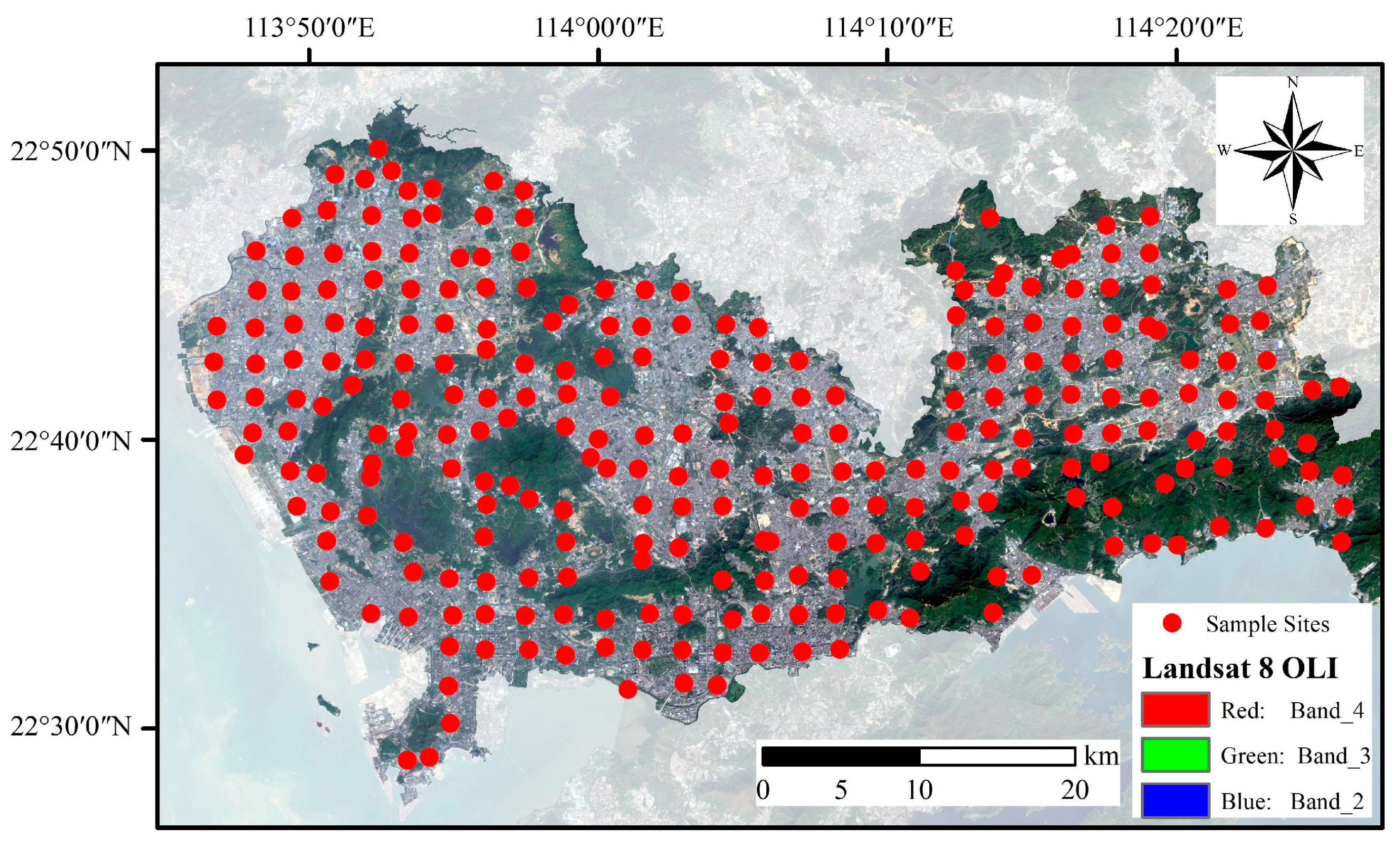


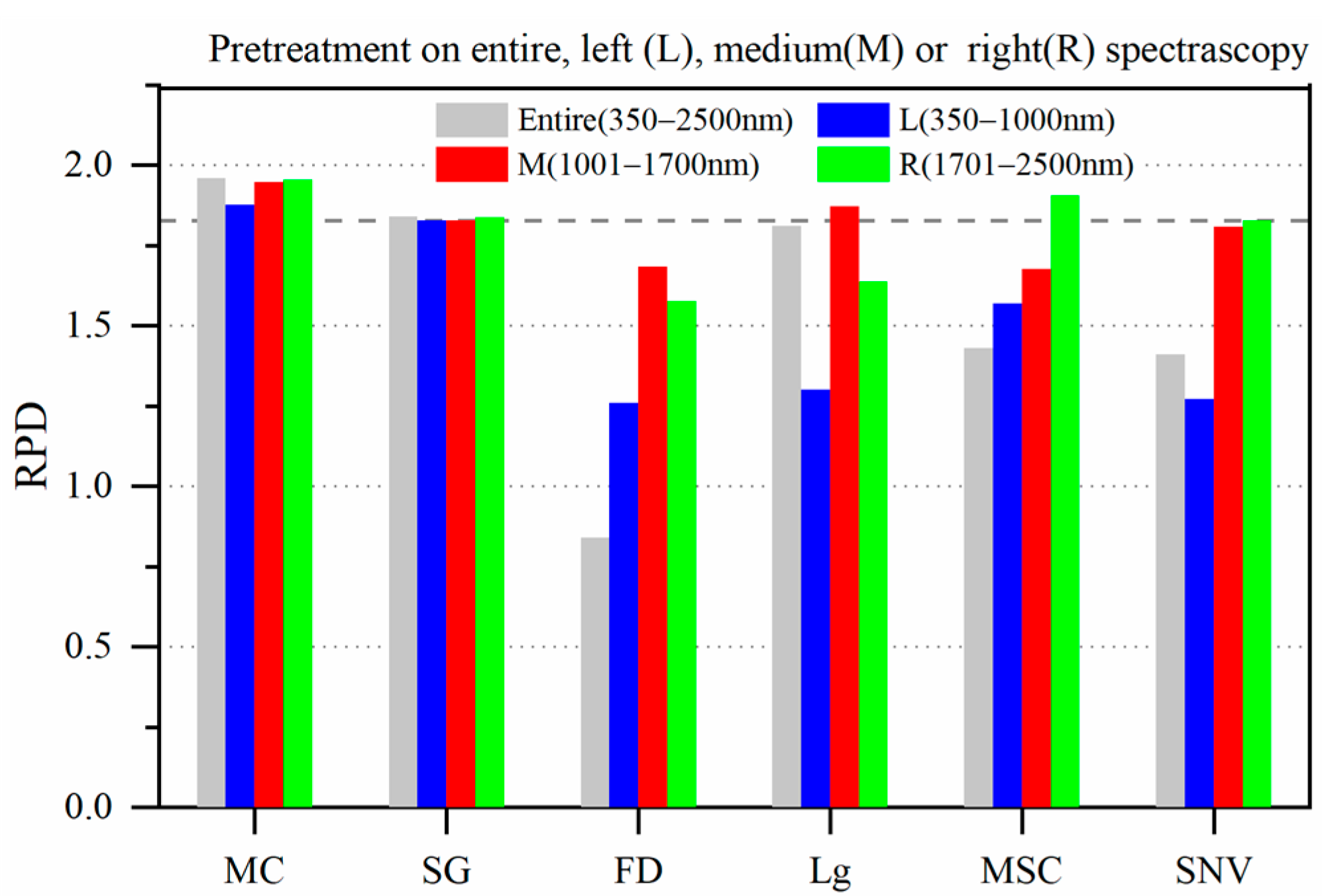
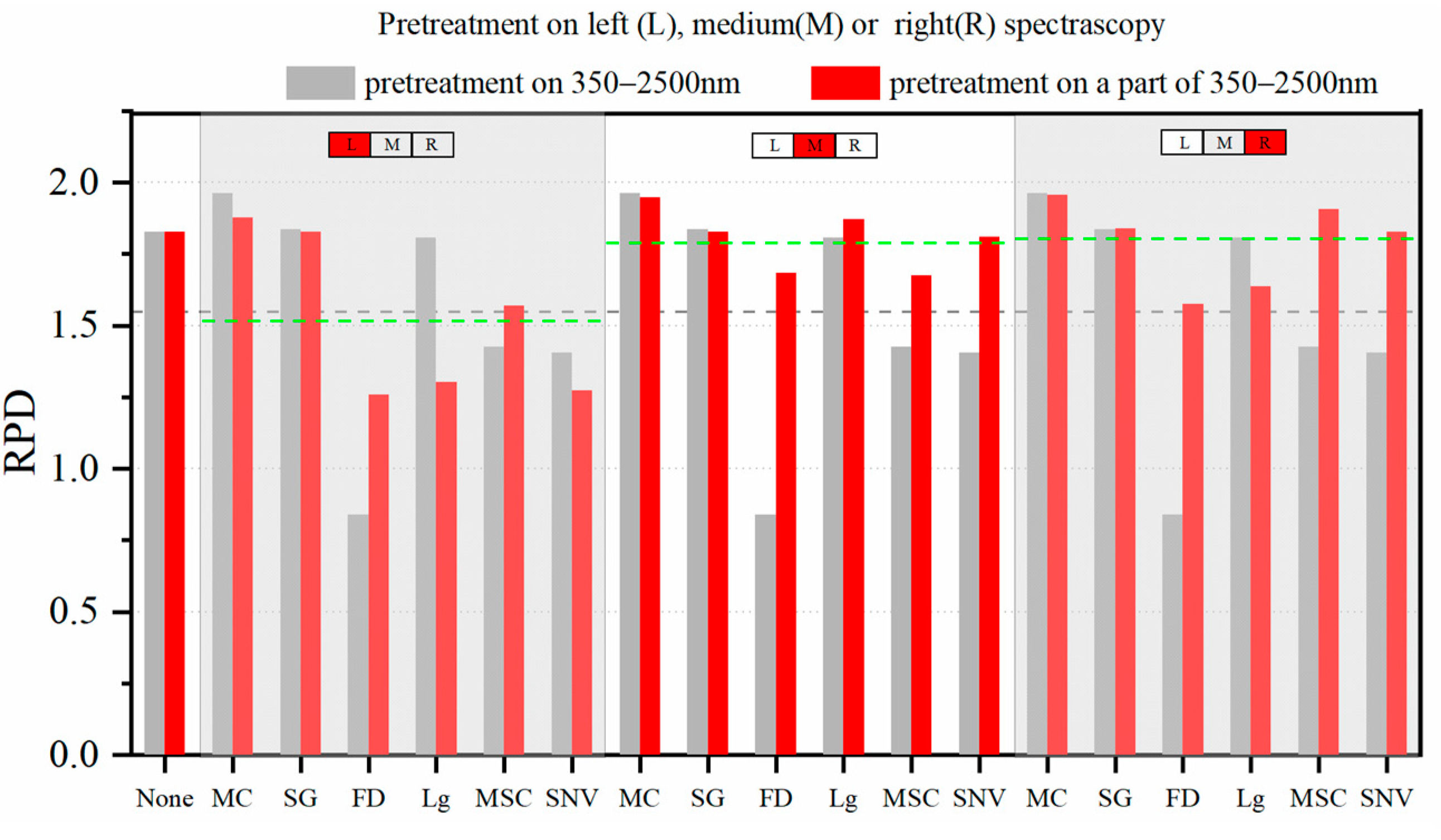

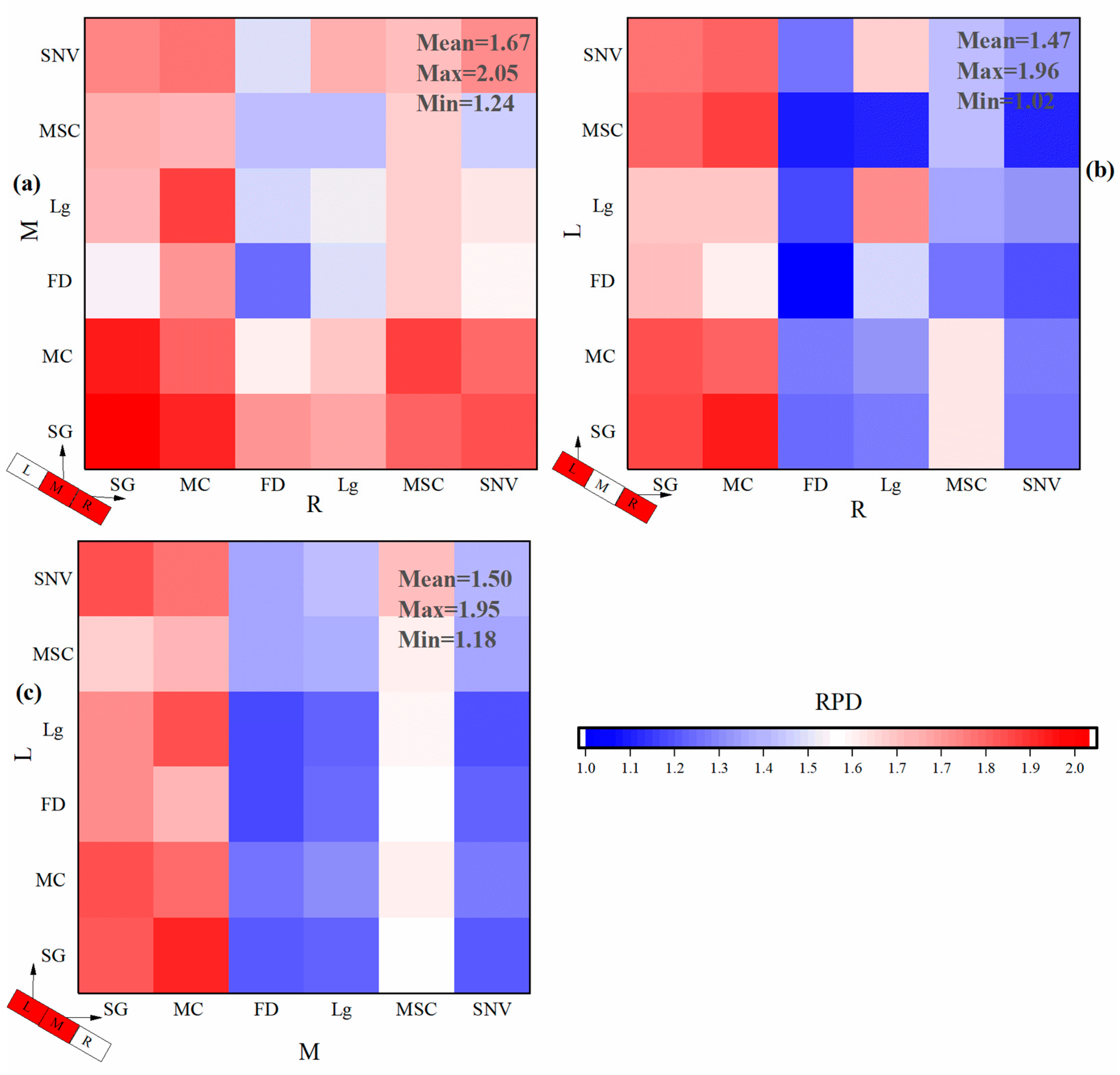
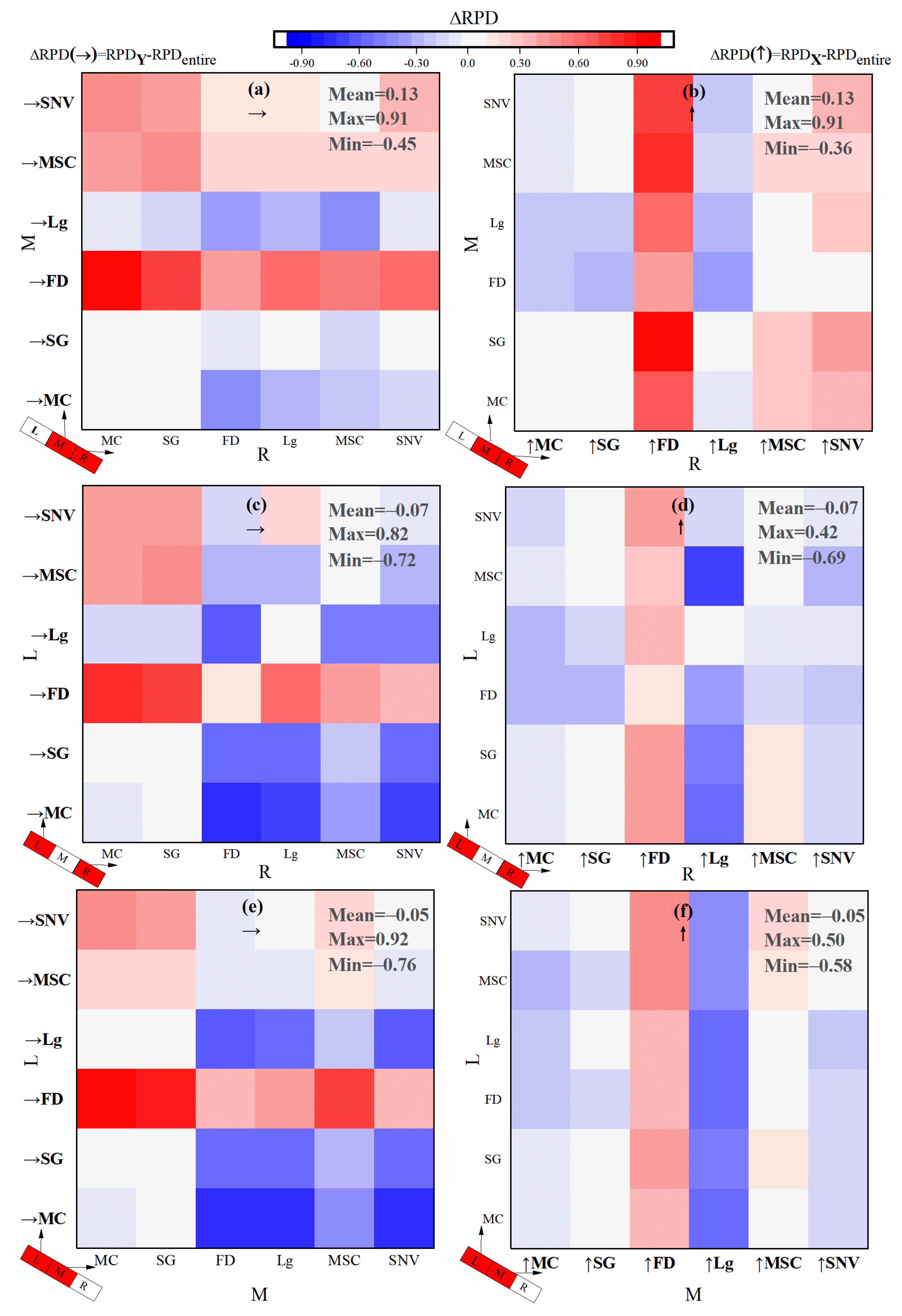

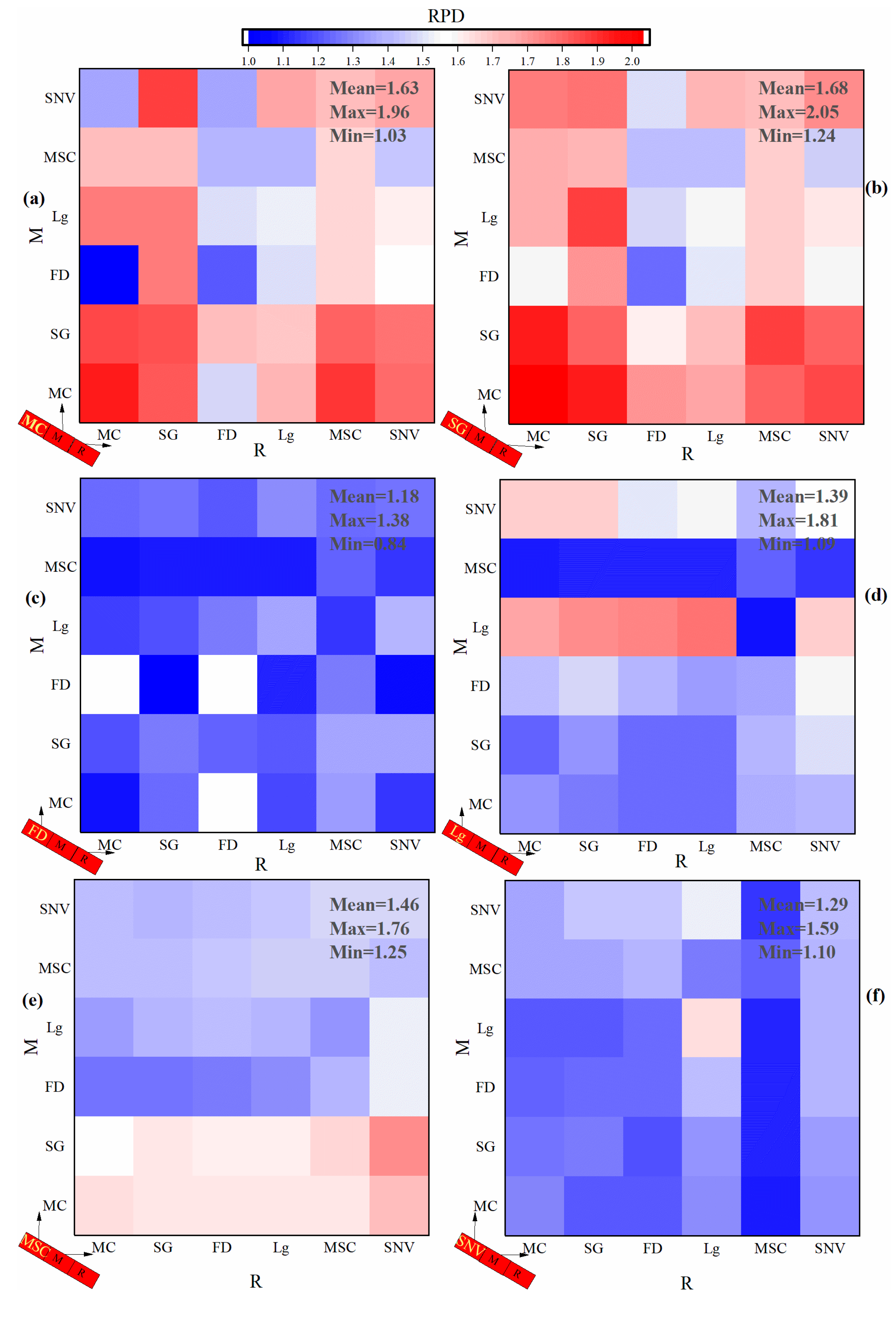
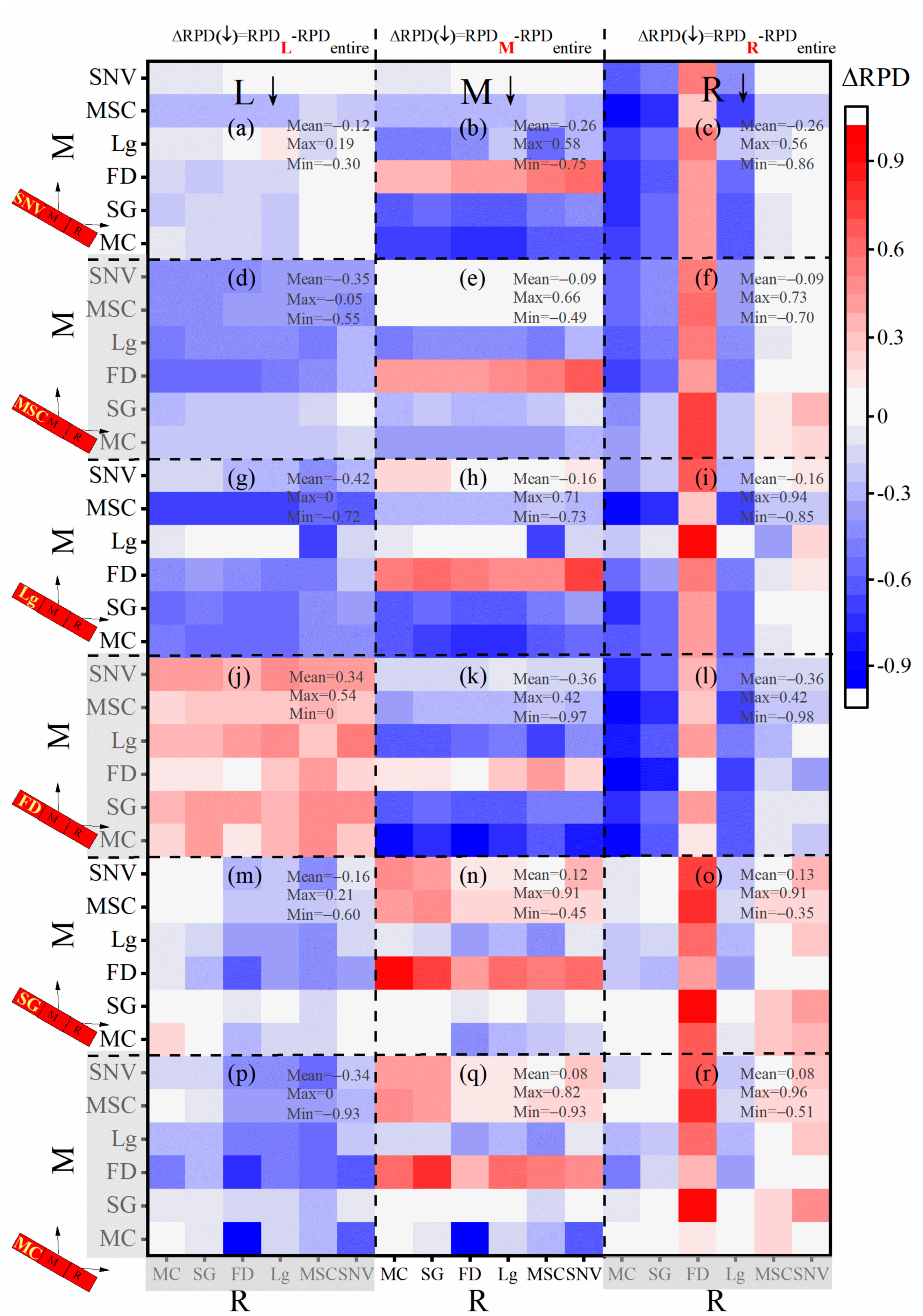


| Sample | Number | Cu (mg·kg−1) | ||||||||
|---|---|---|---|---|---|---|---|---|---|---|
| Range 1 | Min | Max | Median | Mean | Std 2 | CV 3 | Skewness | Kurtosis | ||
| Total | 250 | 82.79 | 20.45 | 103.24 | 59.44 | 58.29 | 15.57 | 0.27 | 0.13 | 0.12 |
| Calibration | 200 | 82.79 | 20.45 | 103.24 | 59.44 | 58.29 | 15.60 | 0.27 | 0.13 | 0.15 |
| Validation | 50 | 71.85 | 25.21 | 97.06 | 59.18 | 58.30 | 15.63 | 0.27 | 0.13 | 0.12 |
| Spectral Pretreatment | Calibration | Validation | LVs | ||||
|---|---|---|---|---|---|---|---|
| RMSEP | RPD | RPIQ | |||||
| None | 0.64 | 9.72 | 0.75 | 8.86 | 1.83 | 2.07 | 6 |
| MC | 0.67 | 8.90 | 0.74 | 7.97 | 1.96 | 2.22 | 6 |
| SG | 0.64 | 9.75 | 0.75 | 8.51 | 1.84 | 2.08 | 6 |
| FD | 0.04 | 20.64 | 0.09 | 18.62 | 0.84 | 0.95 | 8 |
| Lg | 0.63 | 9.56 | 0.70 | 8.66 | 1.81 | 2.04 | 8 |
| MSC | 0.38 | 12.62 | 0.53 | 10.75 | 1.43 | 1.61 | 9 |
| SNV | 0.40 | 12.35 | 0.51 | 11.12 | 1.41 | 1.59 | 9 |
| Indicator | Traditional Pretreatment | Piecewise Pretreatment | ||||
|---|---|---|---|---|---|---|
| Entire Spectra | One-Part | Two-Part | Three-Part | |||
| RPD | Mean | 1.55 | 1.71 | 1.55 | 1.44 | |
| Max | 1.96 | 1.95 | 2.05 | 2.05 | ||
| Min | 0.84 | 1.26 | 1.02 | 0.84 | ||
| ∆RPD | Positive (>0) | Portion | 33.33% | 55.56% | 43.06% | 31.32% |
| Mean | 0.07 | 0.38 | 0.33 | 0.32 | ||
| Max | 0.13 | 0.84 | 0.92 | 0.96 | ||
| Negative (<0) | Portion | 66.67% | 44.44% | 56.94% | 68.68% | |
| Mean | −0.45 | −0.12 | −0.25 | −0.32 | ||
| Min | −0.98 | −0.50 | −0.76 | −0.98 | ||
| MC | SG | FD | Lg | MSC | SNV | ||
|---|---|---|---|---|---|---|---|
| L–M–R | L–M–R | L–M–R | L–M–R | L–M–R | L–M–R | ||
| Traditional pretreatment | MC–MC–MC | SG–SG–SG | FD–FD–FD | Lg–Lg–Lg | MSC–MSC–MSC | SNV–SNV–SNV | |
| 1.96 | 1.84 | 0.84 | 1.81 | 1.43 | 1.41 | ||
| Piecewise pretreatment | One-part | No–No–MC | No–No–SG | No–FD–No | No–Lg–No | No–No–MSC | No–No–SNV |
| 1.95 | 1.83 | 1.84 | 1.87 | 1.91 | 1.83 | ||
| Two-part | No–MC–MC | SG–No–MC | MC–FD–No | No–Lg–SG | No–SG–MSC | No–MC–SNV | |
| 2.04 | 1.96 | 1.76 | 1.90 | 1.91 | 1.88 | ||
| Three-part | SG–MC–MC | SG–SG–MC | MC–FD–SG | SG–Lg–SG | SG–SG–MSC | SG–MC–SNV | |
| 2.05 | 1.96 | 1.80 | 1.90 | 1.91 | 1.88 | ||
Disclaimer/Publisher’s Note: The statements, opinions and data contained in all publications are solely those of the individual author(s) and contributor(s) and not of MDPI and/or the editor(s). MDPI and/or the editor(s) disclaim responsibility for any injury to people or property resulting from any ideas, methods, instructions or products referred to in the content. |
© 2024 by the authors. Licensee MDPI, Basel, Switzerland. This article is an open access article distributed under the terms and conditions of the Creative Commons Attribution (CC BY) license (https://creativecommons.org/licenses/by/4.0/).
Share and Cite
Liu, Y.; Shi, T.; Lan, Z.; Guo, K.; Zhuang, D.; Zhang, X.; Liang, X.; Qiu, T.; Zhang, S.; Chen, Y. Estimating the Soil Copper Content of Urban Land in a Megacity Using Piecewise Spectral Pretreatment. Land 2024, 13, 517. https://doi.org/10.3390/land13040517
Liu Y, Shi T, Lan Z, Guo K, Zhuang D, Zhang X, Liang X, Qiu T, Zhang S, Chen Y. Estimating the Soil Copper Content of Urban Land in a Megacity Using Piecewise Spectral Pretreatment. Land. 2024; 13(4):517. https://doi.org/10.3390/land13040517
Chicago/Turabian StyleLiu, Yi, Tiezhu Shi, Zeying Lan, Kai Guo, Dachang Zhuang, Xiangyang Zhang, Xiaojin Liang, Tianqi Qiu, Shengfei Zhang, and Yiyun Chen. 2024. "Estimating the Soil Copper Content of Urban Land in a Megacity Using Piecewise Spectral Pretreatment" Land 13, no. 4: 517. https://doi.org/10.3390/land13040517








